
Thomas Telford FRS, FRSE was a Scottish civil engineer, architect and stonemason, and road, bridge and canal builder. After establishing himself as an engineer of road and canal projects in Shropshire, he designed numerous infrastructure projects in his native Scotland, as well as harbours and tunnels. Such was his reputation as a prolific designer of highways and related bridges, he was dubbed The Colossus of Roads, and, reflecting his command of all types of civil engineering in the early 19th century, he was elected as the first President of the Institution of Civil Engineers, a post he held for 14 years until his death.

Structural engineering is a sub-discipline of civil engineering in which structural engineers are trained to design the 'bones and muscles' that create the form and shape of man made structures. Structural engineers need to understand and calculate the stability, strength and rigidity of built structures for buildings and nonbuilding structures. The structural designs are integrated with those of other designers such as architects and building services engineer and often supervise the construction of projects by contractors on site. They can also be involved in the design of machinery, medical equipment, and vehicles where structural integrity affects functioning and safety. See glossary of structural engineering.
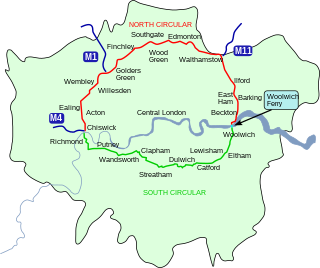
The North Circular Road is a 25.7-mile-long (41.4 km) ring road around Central London in England. It runs from Chiswick in the west to Woolwich in the east, and connects the various suburbs in the area, including Ealing, Willesden, Wembley, Finchley, Bounds Green, Southgate, Edmonton, Woodford, Ilford, and Barking. Together with its counterpart, the South Circular Road, it forms a ring road through the Outer London suburbs. This ring road does not make a complete circuit of the city, being C-shaped rather than a complete loop as the crossing of the River Thames in the east is made on the Woolwich Ferry.
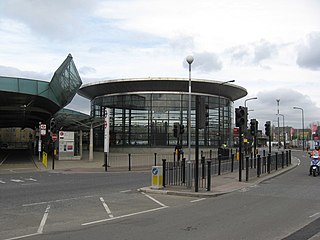
Canada Water is a London Underground and London Overground station located in Rotherhithe, in south London, England. It takes its name from Canada Water, a lake which was created from a former dock in the Port of London.

The Jubilee Line Extension is the extension of the London Underground Jubilee line from Green Park to Stratford through south and east London. An eastward extension of the line was first proposed in the 1970s and a modified route was constructed during the 1990s. It opened in stages from May to December 1999.

The Pontcysyllte Aqueduct is a navigable aqueduct that carries the Llangollen Canal across the River Dee in the Vale of Llangollen in north east Wales. The 18-arched stone and cast iron structure is for use by narrowboats and was completed in 1805 having taken ten years to design and build. It is the longest aqueduct in Great Britain and the highest canal aqueduct in the world.

A railroad tie or crosstie or railway sleeper is a rectangular support for the rails in railroad tracks. Generally laid perpendicular to the rails, ties transfer loads to the track ballast and subgrade, hold the rails upright and keep them spaced to the correct gauge.

The Menai Suspension Bridge is a suspension bridge to carry road traffic between the island of Anglesey and the mainland of Wales. The bridge was designed by Thomas Telford and completed in 1826 and is a Grade I listed structure.
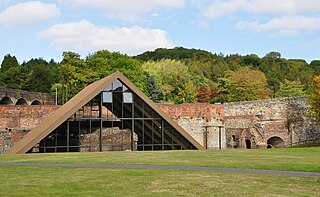
Coalbrookdale is a village in the Ironbridge Gorge in Shropshire, England, containing a settlement of great significance in the history of iron ore smelting. It lies within the civil parish called the Gorge.
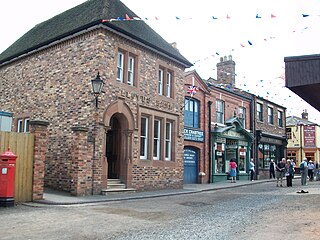
Blists Hill Victorian Town is an open-air museum built on a former industrial complex located in the Madeley area of Telford, Shropshire, England. The museum attempts to recreate the sights, sounds and smells of a Victorian Shropshire town in the late 19th and early 20th centuries. It is one of ten museums operated by the Ironbridge Gorge Museum Trust.

Albert Bridge is a road bridge over the Tideway of the River Thames connecting Chelsea in Central London on the north, left bank to Battersea on the south. Designed and built by Rowland Mason Ordish in 1873 as an Ordish–Lefeuvre system modified cable-stayed bridge, it proved to be structurally unsound, so between 1884 and 1887 Sir Joseph Bazalgette incorporated some of the design elements of a suspension bridge. In 1973 the Greater London Council added two concrete piers, which transformed the central span into a simple beam bridge. As a result, today the bridge is an unusual hybrid of three different design styles. It is an English Heritage Grade II* listed building.

Dawley is a small town in the borough of Telford and Wrekin and ceremonial county of Shropshire, England. Today, it forms part of the new town of Telford, which was originally, in 1963, going to be named 'Dawley New Town' before it was decided in 1968 to name the town 'Telford', after the engineer and road-builder Thomas Telford.

The Royal Tweed Bridge is a road bridge in Berwick-upon-Tweed, Northumberland, England crossing the River Tweed. It was intended to divert traffic from the 17th century Berwick Bridge, and until the 1980s it formed part of the A1 road, the main route from London to Edinburgh. However, the construction of the A1 River Tweed Bridge to the west of Berwick has since reduced the Royal Tweed Bridge's importance.

The Iron Bridge is a cast iron arch bridge that crosses the River Severn in Shropshire, England. Opened in 1781, it was the first major bridge in the world to be made of cast iron, and was greatly celebrated after construction owing to its use of the new material.

Isambard Kingdom Brunel was a British civil engineer who is considered "one of the most ingenious and prolific figures in engineering history", "one of the 19th-century engineering giants", and "one of the greatest figures of the Industrial Revolution, [who] changed the face of the English landscape with his groundbreaking designs and ingenious constructions". Brunel built dockyards, the Great Western Railway, a series of steamships including the first propeller-driven transatlantic steamship, and numerous important bridges and tunnels. His designs revolutionised public transport and modern engineering.

The M54 is a 23-mile (37 km) east-west dual carriageway in the English counties of Shropshire and Staffordshire. It is also referred to as the Telford dual carriageway, after the road's primary westbound destination, the new town of Telford. The dual carriageway cost £65 million to construct, and is two-lane dual carriageway for the majority of its length, with sections of three-lane.
Fritz Leonhardt was a German structural engineer who made major contributions to 20th-century bridge engineering, especially in the development of cable-stayed bridges. His book Bridges: Aesthetics and Design is well known throughout the bridge engineering community.

Cantlop Bridge is a single span cast-iron road bridge over the Cound Brook, located to the north of Cantlop in the parish of Berrington, Shropshire. It was constructed in 1818 to a design possibly by Thomas Telford, having at least been approved by him, and replaced an unsuccessful cast iron coach bridge constructed in 1812. The design of the bridge was innovative for the period, using a light-weight design of cast-iron lattice ribs to support the road deck in a single span, and appears to be a scaled-down version of a Thomas Telford bridge at Meole Brace, Shropshire. The bridge is the only surviving Telford-approved cast-iron bridge in Shropshire, and is a Grade II* listed building and scheduled monument. It originally carried the turnpike road from Shrewsbury to Acton Burnell.
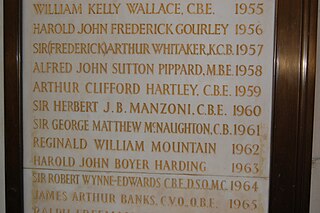
William Kelly Wallace (1883–1969) was an Irish railway engineer who joined the Northern Counties Committee and later became Chief Civil Engineer of the London Midland and Scottish Railway (LMS). He was awarded a civil CBE in the 1946 New Year Honours.

Muṣaffah or Mussafah is an industrial district to the southwest of Abu Dhabi, the United Arab Emirates. Also known as Muṣaffah Aṣ-Ṣanāʿiyah, it is one of the most important economic areas of the United Arab Emirates and has been designated a special economic zone, with numerous factories and port.


















